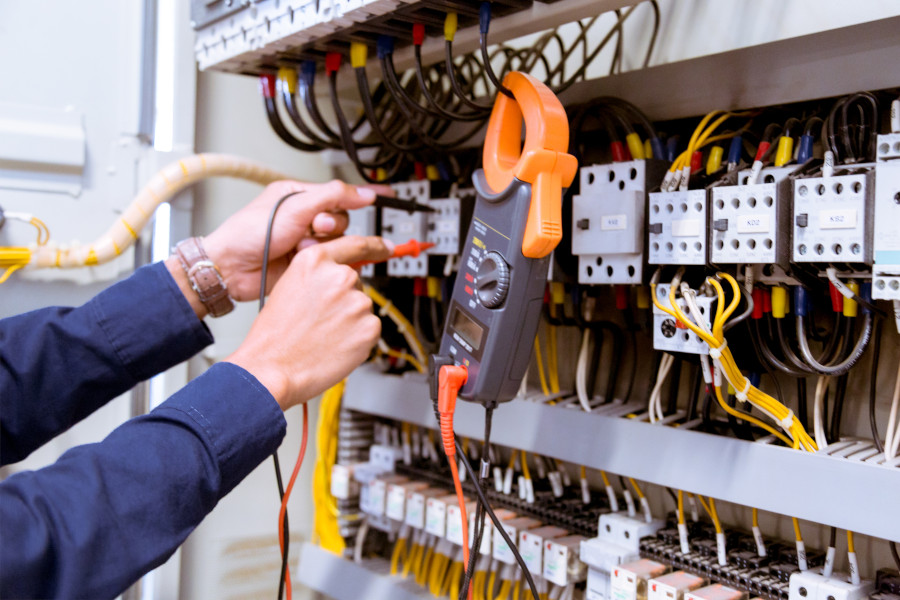
YOUR ONE-STOP ELECRICIAN
PMG Electrical handles all types of electrical and construction projects

CIRCUIT ADDITIONS
Many existing electrical installations require one or more additions or alterations during their lifetime. An addition or alteration may be minor such as the addition of a point to a final circuit, or major such as the addition of new final circuits, distribution circuits, or consumer units

NEW CONSTRUCTION
We provide new construction services such as running all new wiring for building and preventative maintenance.

RECESSED LIGHTS
Recessed lighting is the ideal choice for rooms where ceiling space is limited, be it indoors or out.

TROUBLESHOOTING
It is the process of analyzing the behavior or operation of a faulty circuit to determine what is wrong with the circuit. It then involves identifying the defective component(s) and repairing the circuit. Depending on the type of equipment, troubleshooting can be a very challenging task.

ELECTRICAL WORK
Electrical work means wiring for, installing and repairing electrical apparatus and equipment for electric light, heat, and power… Electrical work means the installation, alteration, reconstruction, or repair of electrical wiring.

VIOLATIONS REPAIRED
Electrical repair is necessary not only because it keeps your home safe, but also because it keeps your electricity well within local and national codes
FEATURED PROJECTS
ELECTRICAL WORKS
LIGHT DESIGN EFFECTIVES
CIRCUIT ADDITIONS WORKS
ELECTRICAL UPGRADES
OUR SERVICES

NEW CONSTRUCTION

SERVICE UPGRADES

GENERATORS

CEILING FANS

RECESSED LIGHTING
OUTDOOR LIGHTING

VIOLATIONS REPAIRED

RENOVATIONS

RECEPTABLES & SWITCHES
FREQUENTLY ASKED QUESTIONS
I have a ceiling fan that is controlled by a remote. When I push the buttons on the remote, nothing happens, or the fan turns slowly.
Most ceiling fan remotes are “aftermarket”. In other words, the ceiling fan did not come with the remote. Most remotes are installed on a ceiling fan designed to be controlled with pull chains. The best thing to do is to set the fan on “hi” using the remote. Then, pull the pull chain until you see the fan start to spin at the desired “hi” setting.
I have a motion sensing light in my back yard. Some nights it stays on all night or just blinks on and off. What is going on here?
Most people install motion-sensing lights to allow light for a pet in the back yard or to thwart a potential burglary. If you are experiencing too many “false alarms”, read on.
Motion sensing lights have a sensitivity dial mounted below the sensor itself. This dial may be set too high for the amount of regular motion in the back yard. Try turning the dial down to decrease the sensitivity of the motion sensor. The sensor will still pick up the motion of a pet or intruder, but will not be activated by a tree or plant blowing in the wind.
A dimmer in my house is very hot to the touch. Should I be concerned?
A dimmer is nothing more than a small transformer that causes the light bulbs to dim by decreasing the voltage applied to them. As the dimmer decreases, the amount of voltage going to the light bulbs, excess heat is generated and radiates from the switch via the switch plate. The heat that you feel is nothing to be concerned about unless you can smell plastic burning or notice the lights flickering.
I have light switches in my house that don’t appear to do anything.
On most occasions the switch does do something, it just isn’t obvious. Many light switches that do not appear to control anything control what is called a “switched outlet”. Switched outlets are sockets in a room in your house that are controlled by a wall switch. These sockets are designed so that a floor lamp can be plugged in and controlled by a wall switch. Most new homes are built with switched outlets as the lighting source because they are less expensive for the builder to install than an actual ceiling fixture.
I found a tripped circuit breaker in my electrical panel, but I cannot turn it back on.
There are a few possibilities here. The first is that the circuit breaker has simply tripped, and needs to be reset. To reset a circuit breaker, the switch must be set completely to the “off” position until you feel a “click”; once the switch has been set to off, set the switch back to the “on” position. If it returns to the “on” position without tripping again, the circuit breaker has been successfully reset. If the circuit breaker will not reset and trips when the switch is set to the “on” position, there may be a short circuit or overload on that circuit. If the circuit breaker cannot be reset, please be sure to call a licensed electrician to evaluate the problem.
The lights in my house will sometimes dim slightly then return to normal. What causes this?
You could be experiencing a “brownout”. Brownouts typically occur during the summer months when air conditioners run continually to keep buildings and houses cool. The power grid gets stressed, causing less electricity to be available to your home. This may cause your lights to dim temporarily.
The other possibility is that there could be a loose neutral connection to the power line connecting to your home or inside your electrical panel. If you experience this problem, first alert the power company. If they cannot determine a problem, call a licensed electrician to handle the problem.
CONTACT US
516 403 0312
108a Laurel Street Roslyn Heights NY 11577
